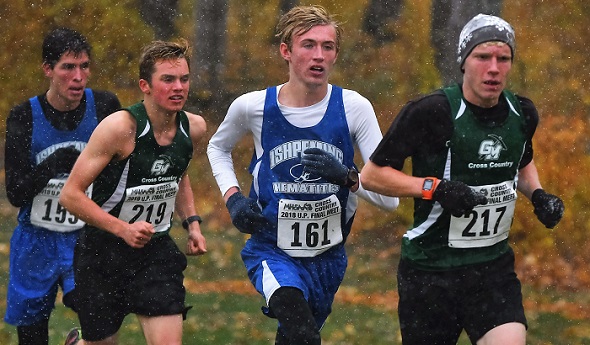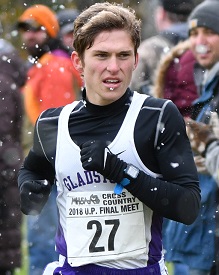
Sault, Ishpeming, Chassell Boys Set Pace
By
John Vrancic
Special for MHSAA.com
October 21, 2018
MUNISING — The Sault Ste. Marie boys made a statement in the wind and cold Saturday, earning their first Upper Peninsula Division 1 cross country championship in six years with 42 points.
Sault, which placed five in the top 14, was followed by reigning champ Houghton with 65, Gladstone 70 and Marquette with 71 points.
“This is the first time all seven of our boys ran together all year,” said Sault coach Jim Martin. “We’ve been banged up all year, but the kids never stopped believing. The parents were very supportive, and the kids were great to work with. They never complained. We knew Marquette would be tough, and Houghton really came on late in the season.”
Gladstone senior Adam Bruce won the 3.1-mile race in 17 minutes, 5.6 seconds at Pictured Rocks Golf Club. He was followed by Houghton junior Joe Wood (17:35.1), Gladstone senior Jake Strasler (17:40.1), Sault junior Kaaleb Ranta (17:47.8) and Gladstone freshman Giovanni Mathews (17:48).
 “My time wasn’t the greatest, but I’m happy with it,” said Bruce. “I’m proud of the way our team ran. If Marquette hadn’t pushed us all year, this wouldn’t have happened. We have a lot of work to do, but we’re pleased. I think this will give us awesome motivation for track.”
“My time wasn’t the greatest, but I’m happy with it,” said Bruce. “I’m proud of the way our team ran. If Marquette hadn’t pushed us all year, this wouldn’t have happened. We have a lot of work to do, but we’re pleased. I think this will give us awesome motivation for track.”
Division 2
Ishpeming completed its first perfect season in school history, taking its fourth title in five years with 32 points. The Hematites were followed by defending champ Gogebic at 47 and Newberry with 70.
“The guys were pretty motivated,” said Ishpeming coach P.J. Pruett. “When one made a mistake, another picked it up. We’ve been doing two meets a week for six weeks. The kids were pretty tired, but they still picked it up.
“We never had any injuries this year. We’re 10 deep and went back and forth all week about who would run today.”
Gogebic senior Uriah Aili earned his first Finals title with the day’s fastest time (17:02.5). He was followed by classmate Devon Byers (17:16) during a snow squall off Lake Superior.
“Devon and I were going to run together and see what happened, and we started pulling away at about 1 1/2 miles,” said Aili. “(Ishpeming) really did good. We had the numbers, but they were just a little better overall.
“It’s awesome to go out this way (as a U.P. champion), and running with my teammates was even better.”
Ishpeming grabbed the next three spots, with senior and last year’s champion Spencer Giroux taking third (17:33.9). He was followed by junior Jonah Broberg (18:00.4) and sophomore Jordan Longtine (18:06.4).
Division 3
Chassell took five of the top 13 places and claimed the D-3 title for the fourth time in five years with 41 points, followed by 2017 champion Brimley with 54 and Rudyard with 72.
 “We anticipated a close race, and our guys wanted to regain the title,” said Chassell coach Marco Guidotti. “All our guys did their best to take the places we needed, and we had some youth really step up.”
“We anticipated a close race, and our guys wanted to regain the title,” said Chassell coach Marco Guidotti. “All our guys did their best to take the places we needed, and we had some youth really step up.”
Brimley senior Austin Plotkin retained his title in 17:23.5, followed by Cedarville junior Thomas Bohn (17:29.5), Brimley sophomore Cameron Hoornstra (17:46.2), Chassell senior Ben Tuomi (17:55.4) and Dollar Bay’s Davin Hill (18:04.3).
“It was quite windy and cold,” said Plotkin. “After the first loop we could feel a lot of heat from the sun (during its brief appearance), but my kneecaps went numb.
“Thomas ran with me most of the way. I was waiting for the wind to be on our back, and that momentum carried me into the home stretch.”
PHOTOS: (Top) Gogebic's Uriah Aili (217) leads the Division 2 pack Saturday with Ishpeming's Spencer Giroux (161) and their teammates Devon Byers (219) and Jonah Broberg (159) following close behind. (Middle) Gladstone's Adam Bruce heads down the home stretch on the way to finishing first in Division 1. (Below) Chassell placed five of the top 13 in Division 3; here Ben Tuomi (258), Kurtis Kytta (255), Gabe Torola (257), Kolson Kytta (254), Abraham Gockenbach (252) and Elijah Soumis (256) break out of the start together. (Photos by Cara Kamps. Click for more at RunMichigan.com.)

MHSAA Vault: MIS Rose to Challenges to Host 2020 LP Finals
By
Rob Kaminski
MHSAA benchmarks editor
November 12, 2021
The “MHSAA Vault” features stories from past publications and other documents in the MHSAA Library. This issue takes a look at the MHSAA Cross Country Finals at Michigan International Speedway, which celebrated 25 years in 2020 – although it was an event that nearly didn’t happen last fall …
In 1996, the MHSAA and Michigan International Speedway began a partnership the changed the course of the Lower Peninsula Cross Country Finals – quite literally.
The land in and around the track at Brooklyn would host the Finals for all classes of runners in one place on one day, an annual festival of nearly 2,000 runners competing for the MHSAA’s top honors.
Even skeptics – and there were several among running purists who thought the course was too flat, for example – can’t deny the results.
Finals attendance nearly doubled in that first year, and crowds in excess of 10,000 have enjoyed a day of racing several times, including a record 12,153 in 2011.
Enthusiastic crowds were the norm in recent years, with 11,232 in 2017, and nearly 11,000 in 2018 (10,989) and 2019 (10,873).
In fact, attendance failed to reach at least 8,000 only twice since the move to MIS.
Of course, last year was an exception, when attendance was limited to 1,000 spectators per session due to the COVID-19 Pandemic. Fans also were restricted to the grandstands rather than following the action throughout locations on the course.
To reduce the number of runners in each race, the event was spread over two days, with each Division being run in two separate “sections” with times then combined at the end to determine team and individual champions.
While not ideal, the end result was another year of fantastic efforts at MIS – both from student-athletes and those behind the scenes.
“Even at the last hour, less than a week ahead of the Finals, we were closer to not having the Finals than we were to having them,” said MHSAA Assistant Director Cody Inglis, who coordinates the cross country postseason. “Rumors and challenges of mandated shutdowns, testing and other requirements were being discussed and caused a lot of unknowns. Even at the Regional level, we had schools, Regional courses and hosts shutting down their facilities; we had to relocate four Regionals 48 hours prior to race times. That scenario just could not happen at the Finals level where far more runners and much more travel would be involved.”
Among the many last-minute hurdles was the edict from NASCAR – which owns MIS – that all persons on site be temperature checked upon entry. That meant securing thermometers that were easy to operate in short order, along with personnel necessary to conduct the readings.
The attendance limitations certainly helped to implement the temperature screening, but brought their own issues.
“Limiting spectators was not a popular decision, but it really was the only way to have a race,” Inglis said. “We were taking direction and working with policies and protocols from the MDHHS, the Governor’s office, Lenawee County Health Department, MIS and NASCAR.”
Part of the solution was to utilize the grandstands as a “barrier” between participants and spectators. The reduced number of fans were dispersed over thousands of seats while still allowing them the chance to watch their student-athletes compete.
“It wasn’t the same, it wasn’t easy or perfect, but it was what we had to do to have a race,” Inglis said. “Separating the Finals into two days and different sections also allowed us to spread out the event and limit the number of people on site at any one time. This was a key part of the plan and worked well even though it separated races within a Division.”
The MHSAA, MIS and the cross country community never lost focus of the main goal: a culmination of the season for the student-athletes, who deserved something last year more than ever. And, more than ever, MIS once again displayed its advantage as a venue that could adapt to the fluid nature of the times to pull off the event.
“There were some thoughts of using four different sites, but as we learned during the Regionals, the climate of things was so tenuous from one area of the state to another that we couldn’t be 100-percent certain that there wouldn’t again be last-minute cancelations,” Inglis said. “MIS was wonderful to work and collaborate with, and was the best option to get it done. It was never mentioned once publicly about the possibility of not having the Finals – only how we could best do it under uncharted conditions.”
The moving parts and ever-changing scenarios created more complexity than ever in finalizing a season, but every decision was made with the complete desire to conduct the Finals as close to normal as possible.
“I firmly believe that a finish to the season, no matter the differences in race formatting and fan experience, was something everyone would have taken when the season began in August,” Inglis said.
Indeed, the finish line in Year 25 at MIS might have been the most gratifying of them all.

